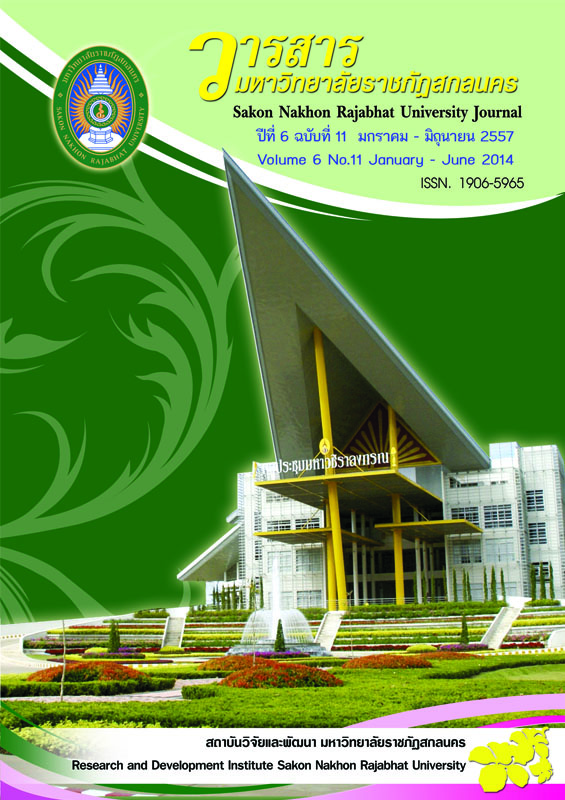การพัฒนากระบวนการผลิตส้มเท้าวัวปลอดภัย
Keywords:
ผลิตภัณฑ์ส้มเท้าวัว, ผลิตภัณฑ์เนื้อหมัก, กล้าเชื้อ, Fermented food, Meat Product, Starter culture, Fermented cattle feet productAbstract
บทคัดย่อ
การพัฒนากระบวนการเพื่อการผลิตส้มเท้าวัวปลอดภัยมีวัตถุประสงค์คือ 1) สำรวจพฤติกรรม ทัศนคติและความต้องการของผู้บริโภคที่มีต่อผลิตภัณฑ์ส้มเท้าวัว 2) คุณค่าทางโภชนาการของวัตถุดิบ 3) พัฒนากรรมวิธีการผลิตโดยใช้กระบวนการทางเทคโนโลยีชีวภาพ 4)ออกแบบบรรจุภัณฑ์ 5) ศึกษาการเปลี่ยนแปลงคุณภาพระหว่างการเก็บรักษาผลิตภัณฑ์ผลการทดลองพบว่า 1) ผู้บริโภคส่วนใหญ่รับประทานส้มเท้าวัว 1 ครั้งต่อเดือน เหตุผลสำคัญที่รับประทานเนื่องจากรสชาติดี อย่างไรก็ตาม มีผู้บริโภคส่วนน้อยที่ไม่เคยรับประทาน เพราะไม่ชอบกลิ่นและไม่มีความปลอดภัยมีความต้องการทราบคุณค่าทางโภชนาการผลิตภัณฑ์มีความสะอาดปลอดภัย มีรูปแบบบรรจุภัณฑ์แบบถุงสุญญากาศ และไม่ต้องการให้รสชาติของผลิตภัณฑ์เปลี่ยนแปลงหลังจากเก็บไว้นาน 2) คุณค่าทางโภชนาการของผลิตภัณฑ์อาหารหมักส้มเท้าวัวมีปริมาณโปรตีน เท่ากับ 13.19 กรัม ปริมาณไขมัน 1.05 กรัมต่อส้มเท้าวัว 100 กรัม และไม่มีเส้นใยอาหารกับน้ำตาลทั้งหมด 3) ผลิตภัณฑ์ส้มเท้าวัวที่ไม่ได้ใช้กล้าเชื้อ และที่ใช้กล้าเชื้อ มีความเป็นกรด – ด่าง (พีเอช) เท่ากับ 4.97 และ 4.83 ตามลำดับ ผลิตภัณฑ์ส้มเท้าวัวที่ใช้กล้าเชื้อมีคุณภาพทางด้านจุลชีววิทยาผ่านเกณฑ์ตามประกาศกรมวิทยาศาสตร์การแพทย์ กระทรวงสาธารณสุข เรื่องคุณภาพทางจุลชีววิทยาของอาหารและภาชนะสัมผัสอาหาร (2553) ทั้งหมดยกเว้นมีปริมาณ Escherichia coli ที่ไม่ผ่านเกณฑ์ส่วนผลิตภัณฑ์ส้มเท้าวัวที่ไม่ได้ใช้กล้าเชื้อ มีปริมาณ Clostridium perfringens Salmonella spp. และ Escherichia coli เกินเกณฑ์ทั้งหมดผลิตภัณฑ์ส้มเท้าวัวที่ใช้กล้าเชื้อมีคะแนนการทดสอบทางประสาทสัมผัสดีกว่าผลิตภัณฑ์ส้มเท้าวัวที่ไม่ใช้กล้าเชื้อในทุกด้านอย่างมีนัยสำคัญทางสถิติ (P–value 0.05) 4) ผู้บริโภคส่วนใหญ่มีความต้องการรูปแบบบรรจุภัณฑ์ผลิตภัณฑ์ส้มเท้าวัว เป็นแบบถุงสุญญากาศ 5) ผลิตภัณฑ์ส้มเท้าวัวที่ใช้กล้าเชื้อหลังการเก็บรักษาที่อุณหภูมิ 4 องศาเซลเซียส พบการเปลี่ยนแปลงในวันที่ 15 หลังการบรรจุคือ มีตะกอนขุ่น และในวันที่ 30 หลังการบรรจุ เริ่มมีกลิ่นจากการหมัก และค่าพีเอชปริมาณลดลงเรื่อย ๆ ในขณะเดียวกันปริมาณกรดทั้งหมดจะค่อย ๆ เพิ่มมากขึ้นตามระยะเวลาในการเก็บรักษา ปริมาณ Escherichia coli ลดลงในวันที่ 30 ของการเก็บรักษาปริมาณน้ำอิสระ Water Activity ปริมาณของ กรดทั้งหมดและปริมาณเชื้อแบคทีเรีย bacteria Bacillus cereus Clostridium perfringens Salmonella spp. และ Staphylococcus aureus มีปริมาณไม่แตกต่างกัน ในทุก ๆ วันหลังการบรรจุ
Abstract
The process development for safety fermented cattle feet were studied as follow 1) consumer behavior, attitude and need on fermented cattle feet 2) nutritional value of raw material 3) process development by using biotechnology 4) product package design 5) quality changes during storage.The results showed that 1) most consume ate fermented cattle feet once a month because it had a good taste, but some consumer didn’t eat fermented cattle feet because of its malodor and unsate. Most consumer preferred to have product in clean, safe, vacuum pack taste stability and nutritional value. 2) Fermented cattle feet were contained protein of 13.19g/100 g, fat of 1.05 g/100 g, no dietary fiber and no total of sugar. 3) The pH of fermented cattle feet without and with starter culture were 4.97 and 4.83, respectively. All microbiological quality of fermented cattle feet with starter culture were above the criteria of microbiological quality standardization of foods and food utensils (2010) prescribed by Department of Medical Sciences, Ministry of Public Health of Thailand except for Escherichia coli. Whereas, the fermented cattle feet without starter culture were below those standard for bacteria content of Clostridium perfringens, Salmonella spp. and Escherichia coli. Fermented cattle feet with starter culture had statistical significantly different of the higher score of all sensory test aspects (P – value 0.05).4) The vacuum pack was the most preferred for the product packaging 5) Fermented cattle feet with starter culture was stored at 4˚C for 30 days. Their appearances were changed at 15 days storage in their turbidity. At 30 days storage, the product showed its fermented odor and the pH were continued declined meanwhile total acidity were continued to increase during storage time. Escherichia coli were declined from 30 days storage. Considering to water Activity, the amounts of Total Lactic acid bacteria, Bacillus cereus, Clostridium perfringens, Salmonella spp. and Staphylococcus aureus were not significantly difference in throughout storage time.









